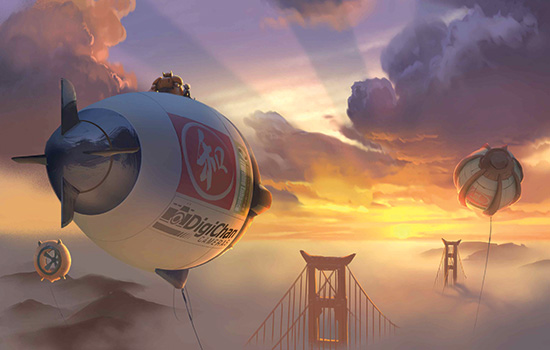Grads play roles in creating hit animated films
Photo courtesy of Disney Animation Studios
Graduates at Disney worked on Big Hero 6, coming out this November.
A little bit of RIT lives inside the Oscar-winning movie Frozen, the highest grossing animated film of all time. It’s in the characters, the costumes and the palaces.
There’s also some RIT in the mob of townspeople in The Simpsons Movie, the city buildings in Rio 2 and the lighting in Epic.
An RIT graduate helped make the hair on the characters in this summer’s How to Train Your Dragon 2. Another came up with the mechanisms that allowed Pascal the chameleon in Tangled to stick out his tongue and curl his tail. A third alumnus planned the facial performance of characters in Coraline.
RIT graduates are making an impact in the thriving animated film world. They are setting up characters, making their hair and clothes move in natural ways, creating backgrounds, supervising artists and lighting shots in many of today’s most popular animated movies.
Dozens of graduates have worked or are currently working at Walt Disney Animation Studios in Burbank, Calif.; Blue Sky Studios in Greenwich, Conn.; LAIKA outside of Portland, Ore.; and DreamWorks Animation in Glendale, Calif.
“If it comes from Disney or Blue Sky, there’s going to be a screen credit for several RIT alumni,” said Malcolm Spaull, administrative chair of RIT’s School of Film and Animation.
They can claim at least three Academy Awards. Along with the best animated feature film Frozen, graduates have worked on Life of Pi, which won an Academy Award for best visual effects in 2013, and Disney’s Paperman, which won best animated short film in 2013.
And more alumni work is in the pipeline, including LAIKA’s The Boxtrolls (September), Disney’s Big Hero 6 (November) DreamWorks’ Home (2015), Blue Sky’s Peanuts (2015) and Disney’s Zootopia (2016).
Making magic
Spaull said most of the students who enroll in RIT’s School of Film and Animation have known since they were little that they wanted to make movies. The school each year receives almost 500 applications for 65 spots. After students complete their first year, they can then decide if they want to specialize in live action or animation.
Brittney Lee ’06 remembers thinking about being an animator when she was growing up in Sharon, Pa. “I loved to draw and general performance arts,” she said. “As I got older, I figured out that animation involved all of those things.”
She moved to San Francisco after graduating and landed a job at a small gaming company animating and designing. But her goal was to work for a feature animation studio, so after 2½ years she started freelancing and worked on her portfolio. She was hired at Disney in the fall of 2009.
As a visual development artist, Lee helped design the 3D computer-animated world of Frozen. The film, inspired by Hans Christian Andersen’s fairy tale The Snow Queen, is about a princess, Anna, who goes on a journey to find her sister, Elsa the Snow Queen, whose powers have left the kingdom in perpetual winter. A mountain man and his pet reindeer, Sven, accompany her on the journey.
Lee helped bring the snow queen’s magic to life and is behind the interior of the ice palace Elsa builds while singing “Let It Go.” She designed the snowflake that emits from Elsa’s foot and the columns, ceiling, balcony and chandelier of the palace.
“We were trying to keep it all consistent, so since I worked on her snowflake, they asked me to do the interior of the palace so it would all feel like it made sense.”
Lee first made the snowflake out of paper before drawing it digitally. The palace was a challenge, she said, because writers were still working on the story as they were designing. They didn’t know, for example, how long Elsa would be there and how the palace would be used. Lee also worked on both the characters and their costumes. The art director wanted Frozen to feel like a grand musical, and elaborate costumes were a key ingredient to making that happen, she said.
Frozen was the first film Lee worked on from concept through production. She had smaller roles on the 2012 film Wreck-It Ralph and in the shorts Paperman and Get a Horse!
Frozen was also the first film Jim Hasman ’01, a production supervisor, worked on from the very beginning to the very end, including helping with advertising and marketing.
Hasman started working with the visual development team overseeing the creation of environments and characters. After artists drew the characters and environments, they were sent to modeling to be made into 3D sculptures on a computer. Hasman ran the environmental modeling department.
Hasman also knew as a child growing up in Webster, N.Y., that he wanted to work in this field. “I used to draw all the time and my mom used to say, ‘Someday you are going to work for Disney,’ ” he remembers.
He took a gamble after graduating and moved with his wife and 3-year-old son to California to pursue that goal.
After three months, he found a job as a writer for a production company that had a contract with the Fine Living Network. His first step into animation was a job with Film Roman working on The Simpsons Movie. One of his tasks was to go through past seasons of The Simpsons television series and pull out cameo characters for background scenes.
Hasman eventually became a production coordinator on the film, overseeing a team that was in charge of painting all the backgrounds and another team that worked with color models.
After working on the movie, Hasman was hired to work on The Simpsons Ride for Universal Studios in Florida and California. From there, he landed his dream job at Disney, working on The Princess and the Frog, The Ballad of Nessie short, Winnie the Pooh, Prep & Landing: Naughty vs. Nice Christmas TV special and then Frozen.
“I grew up loving Disney movies and to be a part of these movies, they are timeless,” he said. “When I go back to Rochester and people come up and say, ‘I didn’t know you worked on that,’ it is an amazing thing. You sometimes forget that people all over the world are watching these films.”
East and west
While Hasman was working his way into the industry on the West Coast, several RIT graduates were breaking into animation on the East Coast.
Christos Tzeremes ’09 didn’t immediately find a job in his field after he graduated, so he started working in fashion in New York City. He worked for corporate Gap, lighting showrooms where Gap representatives from around the world could select clothing to stock their stores. He used his background in 3D lighting on the job.
Tzeremes became interested in lighting while on an internship in New York City for the production and entertainment company Curious Pictures. He was told he could help with lighting or materials.
“I just told him lighting because that’s what came to my head that I wanted to do between those two things,” he said. “They sat me down in front of a computer and said OK, light this shot. I did and they really liked it.”
In February 2010, he got a job at Doodle Pictures Studios in Connecticut working on Lego animations for commercials and websites for four months. He then went to Nickelodeon where he worked on the Nick Jr. show Team Umizoomi.
He managed to get a temporary job working on the film Rio as a lighting assistant. Blue Sky asked him to come back as a lighting temp for Ice Age 4: Continental Drift and he was hired full time in May 2012. As a full-time employee, he has worked on Epic and Rio 2. In Epic, a 2013 film about a teenager who enters another world and fights for good, he had the record for the most lit shots—94, he said.
Lighting comes near the end of the animation process. Tzeremes positions lights that affect how characters and the background look. He makes a shot look rainy or sunny, for example.
Before Tzeremes adds lights, Isaac Holze ’10 works on background scenes. Holze started at Blue Sky shortly after graduation. He had worked at Blue Sky on Horton Hears a Who! on a temporary basis while he was a student. He was assigned to Rio when he returned full time, making the background look like a real environment.
After that was Ice Age 4 and Epic. “For me, Ice Age 4 was a nice chance to be part of what our studio is most famous for currently.”
Epic was one of his favorite films to work on because it was a challenge creating at least a half dozen different worlds, one of which was in a deep-forest setting. For that movie, based on the book The Leaf Men by William Joyce, Holze and other members of his department went out in the woods to give them reference for the forest background.
Holze continued to do backgrounds for Rio 2, helping to build the city Brasilia and working on two of the song sequences.
Holze and Tzeremes are currently working on Peanuts. In that world, Holze said, they have learned less is more and they are working hard to stay true to Charles Schulz’s designs.
“It has been fun to look at those comic strips and learn design elements and composition elements from him,” he said.
Ferris Webby ’07 is also working on Peanuts at Blue Sky, where he started last September. Webby worked at DreamWorks Animation for four years as a rigger, which is the person who adds a skeleton to characters. He tells the computer how and where a character’s body should bend and move as well as its facial expressions.
He worked on the 2011 film Puss in Boots and on Turbo. He did some of the hair work in How to Train Your Dragon 2 and worked on Captain Smek in Home, coming out in March.
Webby left DreamWorks so he could get back to the East Coast to be closer to family. “I know RIT graduates are showing up more and more at studios, and I’m hoping it will continue that way,” he said.
One frame at a time
Along with computer-generated animation, graduates such as Adam Fisher ’10 are leaving their mark in the stop-motion world.
Fisher’s first job was with LAIKA working on the 2009 Academy Award-nominated film Coraline as an animation production assistant. He was offered the job working on the facial performance of the characters while he was still a student, so he put his education on hold and took a leave of absence.
“Coraline was amazing,” he said. “There was so much excitement at the studio because it was their first feature film. There was incredible talent from all the great stop-motion films.”
When that film ended, Fisher finished his thesis and worked for a commercial studio in the area. He went back to LAIKA to work on ParaNorman (also nominated for an Oscar) for 20 months, where he and two others animated all the faces for the film. He also worked on soon-to-be-released The Boxtrolls, a film about an orphaned boy raised by underground cave-dwelling trash collectors who tries to save his friends from an evil exterminator. Most recently, Fisher has been working in Los Angeles as a stop-motion animator on an Amazon Prime show called “Tumble Leaf” for preschoolers.
Fisher physically poses 8-inch puppets on a miniature set and then takes a picture with a camera plugged into a computer. Twenty-four frames later, he has created one second of animation. He films 8 to 10 seconds a day, which is a lot in the stop-motion world.
“It’s a lot like if you see a 6-year-old playing with Legos and G.I. Joes—they are making them move around and acting out scenes,” he said. “We get to do that all day.”
Greg Smith ’06 also worked at LAIKA on Coraline in the research and development group on toolsets and processes. In 2009, he began working at Disney. His first film was Tangled, where he rigged Rapunzel’s best friend, Pascal the chameleon. He also worked on clothing and hair—not a small task in the Rapunzel story.
Smith, who was involved with both Student Government and Reporter magazine while at RIT, became a rigging supervisor on Wreck-It Ralph overseeing the setup of all the characters in the movie and supervising about a dozen people. He also was a rigging supervisor on Frozen.
Because the animation world is small, graduates keep in touch and help each other find positions. Many even work together on films. Hasman said he and Lee worked together for eight months on Frozen before they realized they were both RIT graduates.
On Wreck-It Ralph, Smith supervised David Suroviec ’06, who rigged the characters King Candy and Sour Bill. Suroviec came to Disney in 2011 after rigging Tomb Raider characters for a video game company. (Suroviec and Lee moved to California together and were married in 2012.)
Suroviec also worked on Paperman and rigged Sven the reindeer in Frozen. He is now doing Smith’s job as a rigging supervisor on Zootopia, and Smith has moved up to an associate technical supervisor on the film.
The first time Suroviec and the other artists saw the completed version of Frozen, he said, they knew it was something special. But they had to wait a few weeks before the rest of the world would know, which was tough.
“That’s my favorite part, when the movie is done and we can see the reaction of people who are enjoying it,” Suroviec said. “It’s validation of all that hard work. Having the success Frozen did is incredibly validating. All that hard work was worth it.”
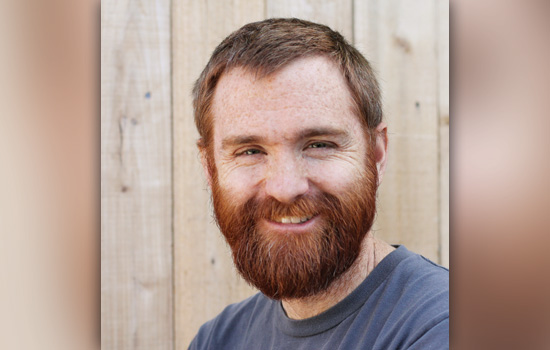 Adam Fisher
Adam Fisher At least eight graduates worked on Disney’s Frozen, which is the highest grossing animated film of all time. Photo courtesy of Disney Animation Studios
At least eight graduates worked on Disney’s Frozen, which is the highest grossing animated film of all time. Photo courtesy of Disney Animation Studios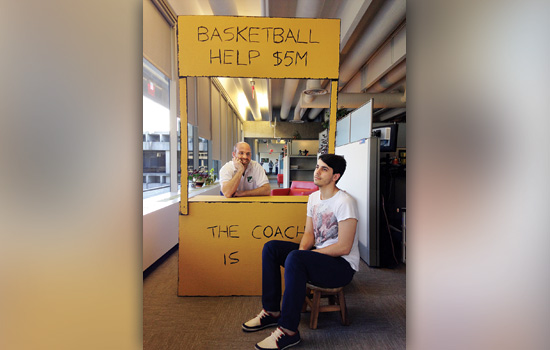 Isaac Holze ’10, left, and Christos Tzeremes ’09 are working on Peanuts at Blue Sky Studios. The movie is scheduled to come out in November 2015.
Isaac Holze ’10, left, and Christos Tzeremes ’09 are working on Peanuts at Blue Sky Studios. The movie is scheduled to come out in November 2015.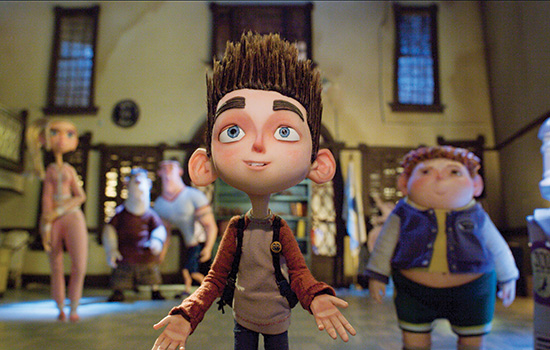 Adam Fisher ’10 animated the faces in ParaNorman. Photo courtesy of LAIKA
Adam Fisher ’10 animated the faces in ParaNorman. Photo courtesy of LAIKA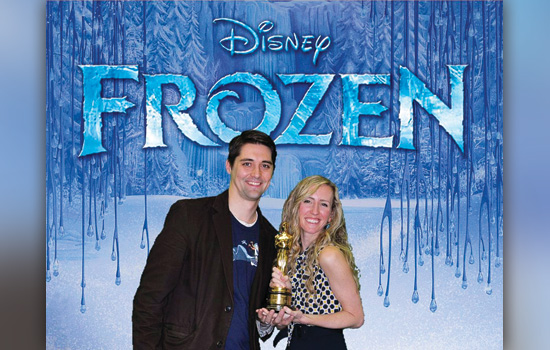 David Suroviec ’06 and Brittney Lee ’06 contributed to the movie Frozen, which won an Academy Award for best animated feature film.
David Suroviec ’06 and Brittney Lee ’06 contributed to the movie Frozen, which won an Academy Award for best animated feature film. Graduates at Blue Sky Studios are working on the 2015 film Peanuts. Photo courtesy of Blue Sky Studios
Graduates at Blue Sky Studios are working on the 2015 film Peanuts. Photo courtesy of Blue Sky Studios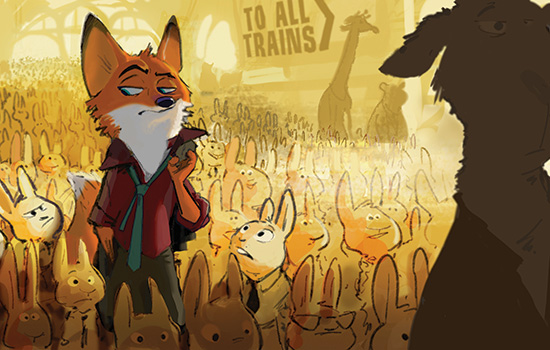 Graduates are currently working on Disney’s Zootopia, which is scheduled to come out in 2016. Photo courtesy of Disney Animation Studios
Graduates are currently working on Disney’s Zootopia, which is scheduled to come out in 2016. Photo courtesy of Disney Animation Studios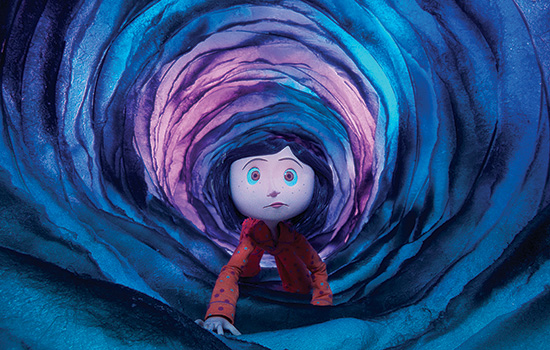 Several alumni helped make the 2009 film Coraline. Photo courtesy of LAIKA
Several alumni helped make the 2009 film Coraline. Photo courtesy of LAIKA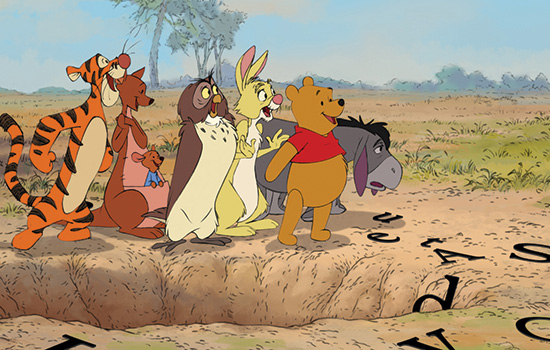 Jim Hasman ’01 has a long list of movie credits, including the Disney classics Winnie the Pooh and The Princess and the Frog. Photos courtesy of Disney Animation Studios
Jim Hasman ’01 has a long list of movie credits, including the Disney classics Winnie the Pooh and The Princess and the Frog. Photos courtesy of Disney Animation Studios Graduates at Blue Sky Studios have also worked on Rio, Rio 2 and Epic. Photo courtesy of Blue Sky Studios
Graduates at Blue Sky Studios have also worked on Rio, Rio 2 and Epic. Photo courtesy of Blue Sky Studios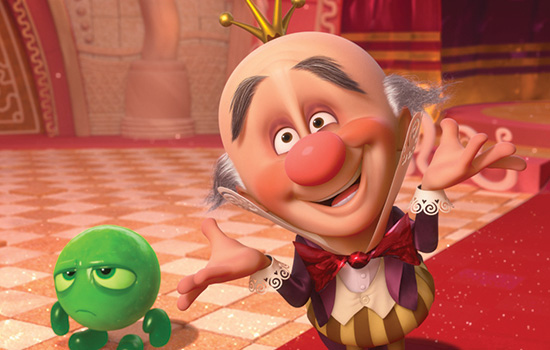 Graduates worked on the 2012 Disney hit Wreck-It Ralph. David Suroviec ’06 helped create antagonist King Candy and Sour Bill. Photo courtesy of Disney Animation Studios
Graduates worked on the 2012 Disney hit Wreck-It Ralph. David Suroviec ’06 helped create antagonist King Candy and Sour Bill. Photo courtesy of Disney Animation Studios








